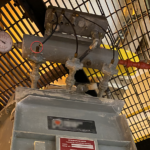
How much are you getting out of your compressed air system? Well, the answer might disappoint you. Most users consider compressed air as a free unlimited resource and rarely hesitate to hook any extra demands to the system without first considering the financial impact.
Consider a typical compressed air powered vane motor that provides a rotating output for an industrial application such as a mixer. To achieve a 1-hp output on the air motor shaft requires an input flow of about 30 cfm of 90 psi compressed air. To produce 30 cfm of compressed air flow at this pressure requires about 8-hp of power input at the air compressor. At this ratio, a compressed air powered motor would cost $2,300 per year to run, compared to $390 for an electric motor. And this is for a perfect lossless system!
In reality, an average of about 25% of the compressed air produced by a real-life compressor will leak out of the system before it gets to the air motor. And the air compressor likely needs to run at much higher pressure than 90 psi to overcome pressure losses in system dryers, filters, pipes, filters, and hoses. This 15 to 20 psi higher pressure will cost about 5% more energy for every 10 psi higher pressure. And often, the air compressor will be running at partial loads, in an inefficient operating mode, decreasing the efficiency of the unit by as much as a factor of two.
These things should be considered before adding any compressed air demand that could more efficiently be supplied by some other source of energy.
Want to know more about compressed air optimization, check out a Compressed Air Challenge Webinar coming soon: https://www.compressedairchallenge.org/calendar





Leave a Reply